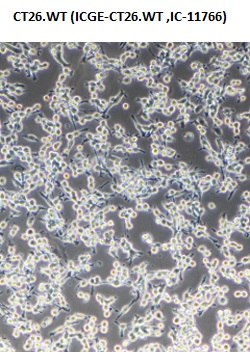

Overview
| Organism | Mus musculus, mouse |
|---|---|
| Tissue | colon |
| Cell Type | fibroblast |
| Product Format | frozen |
| Morphology | fibroblast |
| Culture Properties | adherent |
| Biosafety Level |
1
Biosafety classification is based on U.S. Public Health Service Guidelines, it is the responsibility of the customer to ensure that their facilities comply with biosafety regulations for their own country. |
| Disease | carcinoma |
| Strain | BALB/c |
| Applications |
The cell line can be used with CT26.CL25 as a model for testing immunotherapy protocols and in studies on the host immune response.
|
| Storage Conditions | liquid nitrogen vapor phase |
Properties
| Derivation | CT26 is an N-nitroso-N-methylurethane-(NNMU) induced, undifferentiated colon carcinoma cell line. It was cloned to generate the cell line designated CT26.WT |
|---|---|
| Antigen Expression |
H-2d
|
| Tumorigenic | Yes |
| Effects |
Yes, in BALB/c mice. Mice inoculated, subcutaneously, developed lethal tumors at 80% frequency with 10(3) cells and at 100% with 10(4) cells. Pulmonary metastases developed when mice were inoculated, intravenously, with 10(4) cells.
|
| Comments |
CT26.WT was stably transduced with the retroviral vector LXSN that contains the lacZ gene encoding the model tumor associated antigen (TAA), beta-galactosidase (beta-gal) to obtain the lethal subclone CT26.CL25
The growth rate and lethality of CT26.CL25 and CT26.WT is virtually identical despite the expression by CT26.CL25 of the model TAA, beta-galactosidase, in normal mice.
A culture submitted to the ATCC in July of 2001 was found to be contaminated with mycoplasma. Progeny were cured by a 21-day treatment with BM Cycline.
The cells were assayed for mycoplasma, by the Hoechst stain, PCR and the standard culture test, after a six-week period following treatment. All tests were negative. |
Background
| Complete Growth Medium |
The base medium for this cell line is ATCC-formulated RPMI-1640 Medium, ATCC 30-2001. To make the complete growth medium, add the following components to the base medium: fetal bovine serum (ATCC 30-2020) to a final concentration of 10%. |
|---|---|
| Subculturing |
Volumes used in this protocol are for 75 cm2 flask; proportionally reduce or increase amount of dissociation medium for culture vessels of other sizes.
Subculture ratio: 1:4 to 1:10
Medium Renewal: Every 2 to 3 days.
Note: For more information on enzymatic dissociation and subculturing of cell lines consult Chapter 10 in Culture of Animal Cells, a manual of Basic Technique by R. Ian Freshney, 3rd edition, published by Alan R. Liss, N.Y., 1994
|
| Cryopreservation |
Freeze medium: Complete growth medium supplemented with 5% (v/v) DMSO
Storage temperature: liquid nitrogen vapor phase
|
| Culture Conditions |
Atmosphere: air, 95%; carbon dioxide (CO2), 5%
Temperature: 37��C
|


